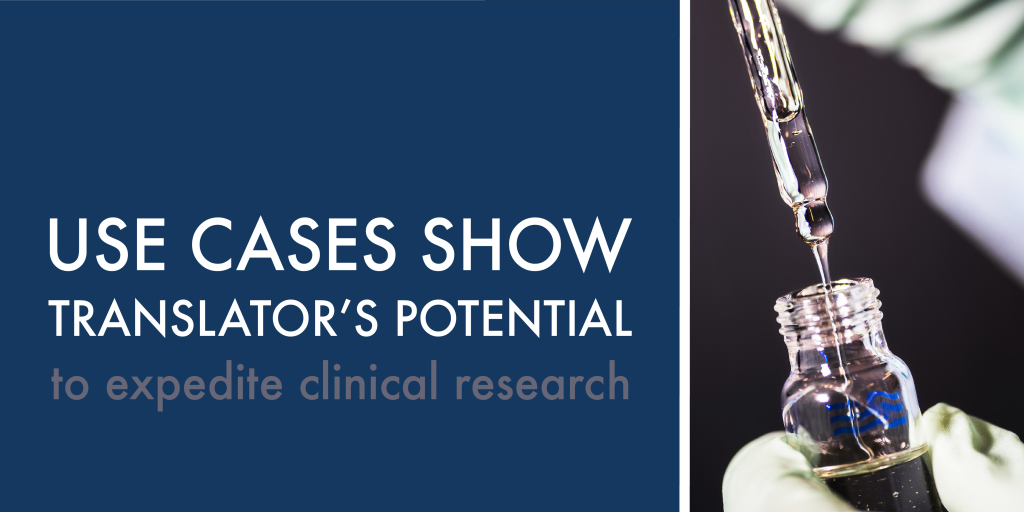
RENCI investigators are contributing to the development of a platform called Biomedical Data Translator that will allow researchers to easily access and interrelate large amounts of data relevant to advancing biomedical research. Funded by the NIH’s National Center for Advancing Translational Sciences (NCATS), the new system is poised to accelerate translational clinical research by allowing users to approach biomedical questions from a holistic perspective to inspire important new research directions.
The platform is being developed by a 15-team multi-institutional Biomedical Data Translator consortium. Three of these teams include leadership from RENCI investigators. Although still a work in progress, Translator is being designed as an easy-to-use tool that can quickly respond to queries by identifying and synthesizing relevant data from a wide variety of sources.
Finding potential therapies for drug-induced liver injury
In December 2021, consortium members presented use cases to NCATS to demonstrate the platform’s progress and potential. In one, Paul Watkins, MD, from the UNC School of Medicine worked with RENCI collaborator Karamarie Fecho to use Translator to identify drugs that might be repurposed for treating drug-induced liver injury (DILI). There is a critical need for new therapies to heal liver damage caused by medicines. Although the injury sometimes heals when a patient stops taking the medication, it can take months or years to resolve and can leave patients unable to take medicines they need to treat medical conditions.
“There are lab-based ways to identify drugs for repurposing, or a researcher can spend years going through the literature and attempt to synthesize it,” explained Fecho. “Translator offers an alternative method that’s fast and doesn’t require the user to be an expert.”
Using gene information to identify drug candidates that might hold promise for treating drug-induced liver injury, Translator quickly identified two antioxidant drugs for consideration. This query relied on clinical data that is part of UNC Health’s Integrated Clinical and Environmental Exposures Service (ICEES), which provides open, regulatory-compliant access to clinical data that is integrated with environmental exposures data. Fecho and colleagues from RENCI and the North Carolina Translational and Clinical Sciences Institute previously developed tools that allow Translator to access this important source of clinical data.
In addition to identifying potential drug candidates, Translator also provided experimental evidence that these drugs had been studied for preventing drug-induced liver injury in rat models and were used in clinical trials to treat other diseases. “Having this information showed that the candidate drugs were safe and effective enough to be used in a clinical trial,” said Fecho. “This can help reduce the risk involved in moving forward with clinical trials, which are time-consuming and expensive.”
The Translator findings are now being compiled into a formal report to present to the NIH-funded U.S. DILI Network leadership to inform planning for future clinical trials.
Revealing new directions for rare diseases
In another use case, researchers from the Hugh Kaul Precision Medicine Institute at the University of Alabama, Birmingham, are using Translator to find potential new treatments for rare diseases. Rare diseases are usually caused by gene mutations that aren’t passed on.
“For applications involving rare diseases, a new drug development candidate is not that helpful because it would require too much investment to develop and test a new drug for just a few people,” said RENCI’s Chris Bizon, co-PI of the Translator standards and reference implementation team. “Translator can help by looking for drugs that are already approved for some other purpose and have the potential to be repurposed for off-label use or tested in a clinical trial.”
The researchers were interested in a gene known as RHOBTB2. Children born with overactive variants of this gene sometimes never learn to walk and have severe intellectual disabilities. Researchers used Translator to ask for a list of all the chemicals that down-regulate RHOBTB2. When this didn’t return many leads, they performed another query to look for chemicals that up-regulate a gene that down-regulates RHOBTB2. This process helped reveal intermediate genes that could be targeted to down-regulate RHOBTB2.
“As a clinician, I don’t even know about all the databases that hold critical pieces of the puzzle I’m trying to put together,” said Anne Thessen, a visiting associate professor the University of Colorado School of Medicine. “With Translator I can prepare a query, run the query, and have results to review in an hour.”
Read more about Translator:
Biomedical Translator Platform moves to the next phase


